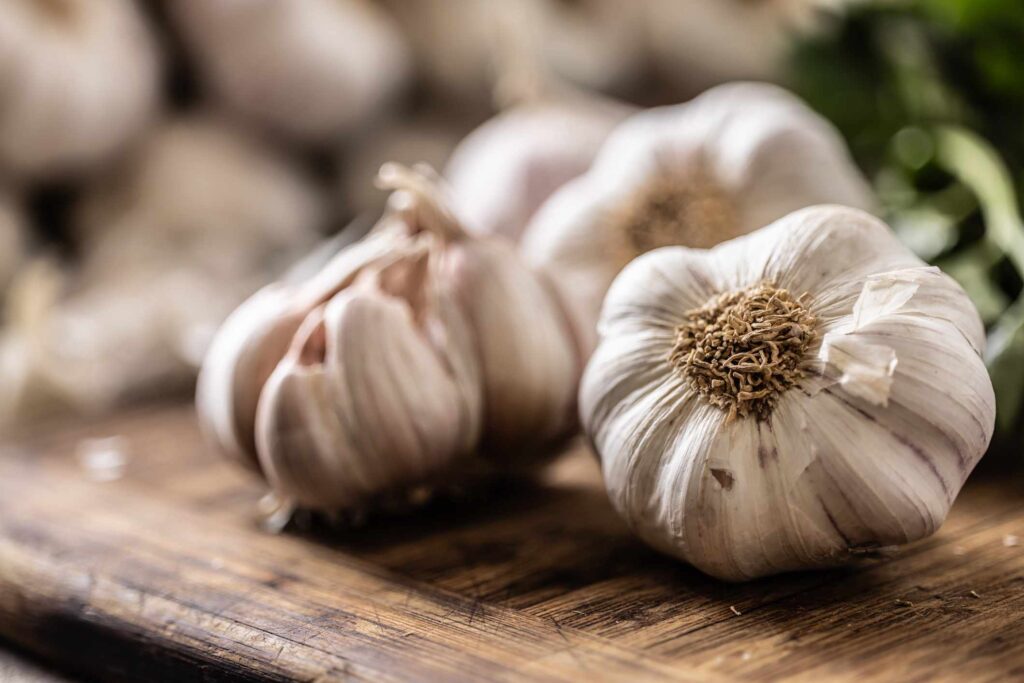:max_bytes(150000):strip_icc():format(jpeg)/Garlic-547276b9a356409eacef7284682b594a.jpg)
Have you ever wondered if the garlic called for in so many recipes actually has any health benefits? Because of its concentration of protective plant compounds, garlic may support your well-being in several ways, including reducing markers of inflammation and lowering chronic disease risk.
Here’s everything you need to know about garlic, including its primary health benefits.
Although some types of inflammation are critical to keeping your body healthy and preventing illness, chronic or long-term inflammation is associated with several diseases, such as certain cancers and heart disease. Garlic is loaded with anti-inflammatory substances called organo-sulfur compounds—but the presence of anti-inflammatory compounds depends on the preparation method.
For example, fresh garlic bulbs are high in S-allyl-L-cysteine sulfoxide (alliin) and γ-glutamyl cysteine derivatives, while garlic powder contains diallyl disulfide (DADS) and alliin. Ground garlic is rich in dithiines, (E–Z)-ajoene compounds, and sulfide family compounds.
Studies show that consuming garlic can help reduce inflammatory markers such as tumor necrosis factor-alpha (TNF-α), C-reactive protein (CRP), and interleukin-6 (IL-6).
Consuming garlic may support brain health by improving cognitive function and protecting against cognitive decline. Studies show that people who follow diets rich in garlic have lower rates of cognitive decline and impairment.
A 2019 study that included data on over 27,000 senior Chinese people found that those who consumed garlic five or more times per week were less likely to be cognitively impaired and tended to live longer compared to people who consumed garlic infrequently.
Garlic supplements have also been shown to improve short-term attention and memory. Researchers believe that the antioxidant and anti-inflammatory compounds found in fresh and dried garlic may help reduce inflammation in the brain and protect against nerve cell degeneration, which could help support overall brain health and reduce the risk of cognitive decline.
Adding garlic to your diet could help reduce your risk of several chronic diseases, including heart disease and certain cancers.
Atherosclerosis, the medical term for plaque buildup in the arteries, is the main underlying cause of heart disease. Eating garlic may help reduce heart disease risk by decreasing atherosclerosis. A 2021 study that included information on 4,329 Chinese adults found that, compared with participants who ate raw garlic less than one time per week, people who consumed raw garlic once per week and two to three times per week had a 26% and 29% reduced risk of thickened carotid intima-media, respectively. Carotid intima-media thickness (cIMT) is an early marker of atherosclerosis and is used to assess heart disease risk.
Some people swear by taking garlic-based products—such as garlic and ginger shots—when they’re feeling under the weather. Studies suggest that garlic compounds have powerful antiviral, antibacterial, antioxidant, and anti-inflammatory effects in the body, which could help support your immune system and reduce your risk of becoming sick.
Garlic compounds, such as allicin and diallyl sulfide, can help inhibit inflammatory proteins and enhance immune cell activity. Garlic also demonstrates significant antiviral activity against pathogens that cause common illnesses like respiratory infections and some types of influenza.
Non-alcoholic fatty liver disease (NAFLD) is a common condition characterized by the buildup of excess fat in the liver. NAFLD is one of the most common causes of liver disease in the United States. A 2019 study that included 24,106 men and women found that men who consumed raw garlic four to six times per week had up to a 34% reduced risk of developing fatty liver disease. However, this association was not seen in women.
Additionally, studies show that garlic powder supplements could help improve certain aspects of liver health, such as the liver damage markers alanine transaminase (ALT) and aspartate aminotransferase (AST), in people with NAFLD.
Garlic is rich in protective plant compounds but is usually consumed in small amounts. Therefore, when consumed in small doses, garlic does not contribute a significant amount of nutrients, such as fiber, vitamins, and minerals.
Here is the nutrition breakdown for three cloves of garlic:
- Calories: 13.4
- Protein: < 1 gram (g)
- Fat: < 1 g
- Carbohydrate: 2.98 g
- Fiber: < 1 g
Garlic does provide small amounts of certain nutrients, such as vitamin C and potassium, but not enough to contribute in any significant way to daily nutrient intake.
When consumed in normal amounts, garlic isn’t associated with major health risks and is safe for most people to consume, including pregnant and breastfeeding women.
That said, concentrated garlic supplements aren’t appropriate for everyone. In high doses, garlic may be unsafe for people at risk for bleeding, such as those on blood-thinning medications and people with blood clotting disorders. If you have an allergy to a plant in the lily family, such as leeks, chives, and tulips, you should consider avoiding garlic supplements.
High-dose garlic ingestion may also cause gastrointestinal symptoms, bad breath, and body odor.
Take caution if using raw garlic topically, as garlic can burn the skin and lead to other issues, such as skin inflammation.
Garlic can be enjoyed in a number of recipes and can also be added to drinks and wellness shots.
Here are a few ways to incorporate garlic into your diet:
- Add roasted garlic to dishes like pasta, soups, stir-fries, and noodle dishes
- Combine chopped garlic, fresh ginger, lemon, and honey in hot water for a soothing, anti-inflammatory tea
- Use garlic powder to add flavor to savory recipes
- Make your own fire cider with fresh garlic, ginger, apple cider vinegar, honey, horseradish, and hot peppers
- Mix roasted garlic cloves into mashed potatoes, hummus, and sandwich spreads.
If you’re cooking garlic, it’s important to note that the cooking process deactivates an enzyme called allinase, which converts allinin to allicin, the main active beneficial compound found in garlic.
Alliinase is activated when garlic is crushed or chopped, so, if you’re cooking garlic, experts suggest letting the chopped garlic sit for roughly ten minutes before cooking. Letting the garlic sit for a short time will allow the allicin to develop, which makes the garlic more beneficial for health.
Garlic is a popular cooking ingredient that’s been linked to a number of health benefits.
Regularly consuming garlic may benefit the health of the brain, heart, and liver, and may help regulate inflammation and support immune function.
Try adding garlic to savory dishes like soups and pastas or making wellness teas or shots with fresh garlic, ginger, lemon juice, and honey.













